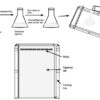Category: Lab Notes: Recombinant DNA Technology
Protocol – Preparing Liquid Culture of E. coli for Plasmid Miniprep
![]()
Overview:
Small-scale plasmid isolation, called plasmid miniprep, requires a small amount of bacterial culture. Normally, a 2 – 5 ml culture provides sufficient cells that can be processed for plasmid isolation using the miniprep protocol. Culture can be prepared by inoculating 3 ml antibiotic-containing growth medium with a single colony and growing it overnight at 37C with shaking.
Here we have taken an example of preparing liquid culture from a colony of E. coli DH5α, transformed with the pEGFP plasmid. The pEGFP plasmid contains a kanamycin resistance gene, therefore, requires kanamycin for the selection of plasmid-containing bacteria. If your plasmid carries another antibiotic-resistant gene, add the respective antibiotic to the culture medium.
Preparation of Glucose-containing Resuspension Buffer for Plasmid Isolation by Alkaline Lysis Method
![]()
Overview: Resuspension buffer is used to resuspend the harvested bacterial cells from the culture during plasmid isolation by the alkaline…
Preparation of Neutralization Solution (Solution III) for Plasmid Isolation by Alkaline Lysis Method
![]()
Overview The neutralization solution (solution III) is used for the isolation of plasmid DNA by the alkaline lysis method. The…
Preparation of Lysis Solution (Solution II) for Isolation of Plasmid by Alkaline Lysis Method
![]()
Overview Lysis solution (solution II) is used for the isolation of plasmid DNA by the alkaline lysis method. The plasmid-containing…
Plasmid Isolation
![]()
To isolate plasmid from the host bacteria, cells are first lysed that lead to the release of plasmid and in subsequent steps, the plasmid is purified from the lysate. Purification of plasmid from the lysed cells are mostly dependent on the type of lysis method used to release plasmid in solution. For example, alkaline lysis which completely disrupts the bacterial cells leading to the release of cell components including both plasmid DNA and genomic DNA in denatured state relies on selective renaturation of only plasmid DNA in a perfect manner at the purification step. On the other hand, boiling lysis selectively releases only plasmid DNA from the bacterial cells. The purified plasmid can be further purified by a number of methods to obtain high quality plasmids. These methods are centrifugation in gradients of CsCl – ethidium bromide (EtBr), selective precipitation in high salt SDS, extraction with Phenol-chloroform, and hydroxylapatite and ion-exchange chromatography.
Phenol-Chloroform Extraction of Nucleic Acid
![]()
Phenol-chloroform extraction can be used to isolate and purify nucleic acid (DNA and RNA). It is a very reliable method…
Growing Escherichia coli for Plasmid Isolation
![]()
Amplification of plasmid is desirable for many applications including gene cloning, DNA sequencing, transfection, and probe preparation. The fastest and routinely used method to amplify plasmid is to introduce plasmid in an appropriate strain of E. coli e.g., DH5α (the process is called transformation), grow them to a suitable culture volume, and finally, extract plasmid from them (the process called plasmid isolation).
Preparation of Resuspension Buffer Containing Tris and EDTA for Isolation of Plasmid by Alkaline Lysis Method
![]()
Overview: The resuspension buffer is used to resuspend bacterial cells during plasmid isolation by the alkaline lysis method. It provides…
Resuspension Buffer (Solution I) for Isolation of Plasmid by Alkaline Lysis Method
![]()
Resuspension buffer (solution I) is used for the isolation of plasmid DNA by alkaline lysis method. Bacterial cells, obtained from…
Basic Steps in Plasmid Isolation
![]()
Plasmid isolation is a common task in molecular biology laboratories. Tasks as simple as amplifying a plasmid vector to complex…
Protocol – Plasmid Isolation by Alkaline Lysis Method (Miniprep)
![]()
OVERVIEW The alkaline lysis method of plasmid isolation was originally developed by Brinboim and Doly (1979). In this procedure, bacteria…
Protocol: Running DNA Samples in Agarose Gel
![]()
Agarose gel is placed in an electrophoresis tank filled with an electrophoresis buffer. DNA samples are mixed with DNA loading dye and loaded onto the wells of agarose gel. Electrophoresis apparatus is connected to electric supply and electrophoresis is performed at constant voltage until the desired separation among DNA fragments is achieved. After the run is over, gel is analyzed using UV-transilluminator or Gel Doc system.
Protocol: Preparation of Agarose Gel for DNA Analysis
![]()
Agarose Gel is a gelatin-like slab, which contains small wells for loading DNA samples. It is prepared by melting agarose in a suitable electrophoresis buffer. Molten agarose is then poured into a specialized tray (casting tray), which controls the size and shape of the gel. The comb is used to create wells in agarose gel.
DNA Loading Dye
![]()
DNA sample is mixed with DNA loading dye (also called sample loading dye) prior to loading onto the wells of agarose gel for electrophoresis. DNA loading dyes contain a high-density reagent and tracking dyes. DNA loading dye makes the DNA sample heavier and coloured, thus helping the DNA sample to sink into the agarose wells without diffusing out and enabling us to monitor the loading process. In addition, tracking dyes in loading dye migrate as a diffuse band to the same direction as DNA which can be seen visually thus allowing us to monitor the progression of electrophoresis. However, tracking dyes sometimes interfere in the analysis of DNA bands by masking it.
Preparation of 6X DNA Loading Dye (Bromophenol blue, Xylene Cyanol FF, Ficoll 400)
![]()
10 ml of 6x DNA loading dye containing Bromophenol blue, Xylene cyanol FF, and Ficoll 400 is prepared by dissolving 25 mg bromophenol blue, 25 mg xylene cyanol FF and 1.5 g Ficoll 400 in water to a final volume of 10 ml. The final solution (6x DNA loading dye) will contain 0.25% (w/v) bromophenol blue, 0.25% (w/v) xylene cyanol FF, and 15% (w/v) Ficoll 400.

